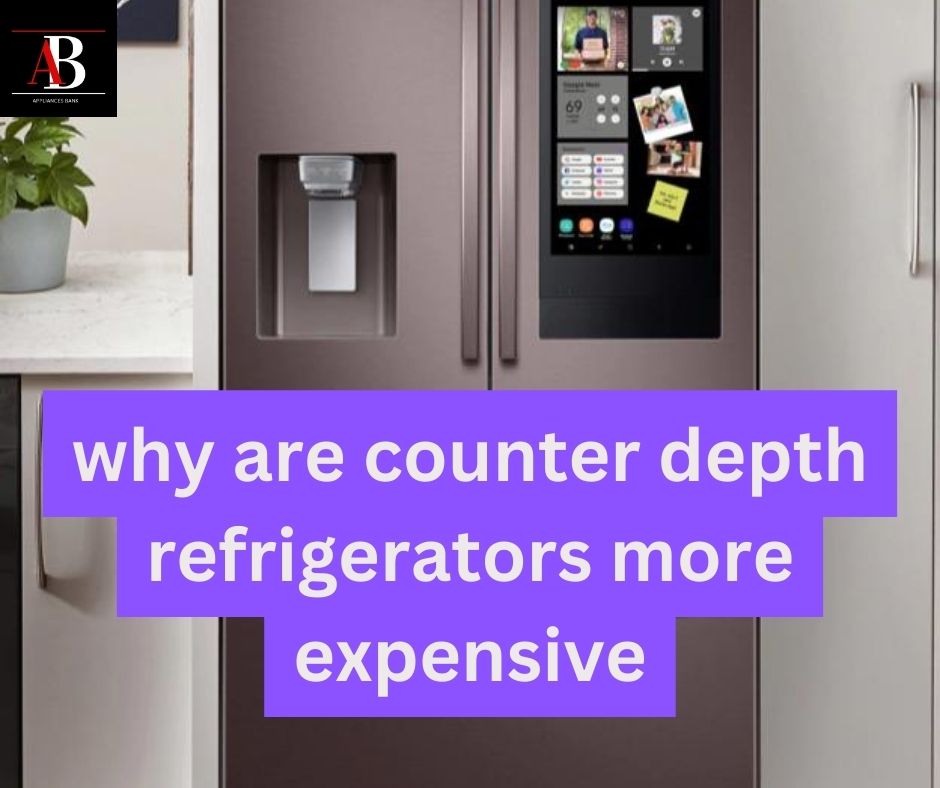Why Are Counter Depth Refrigerators More Expensive
There are several factors that contribute to counter-depth refrigerators costing more than standard-depth refrigerators. For starters, they are meant to be flush with kitchen counters and cabinets, which necessitates more exact measurements and a more personalized production process. This can raise production costs. Furthermore, counter-depth refrigerators sometimes offer more advanced features and finishes than normal depth models, which might raise the price. Finally, because they are less frequent and have a more specialized design, they may be manufactured in lower quantities, contributing to their greater cost.

Is it worth it to buy a counter-depth refrigerator?
The value of a counter-depth refrigerator is determined by your unique demands and budget. Consider the following factors when choosing if a counter-depth refrigerator is best for you:
- Kitchen layout: If you have a tiny kitchen or a limited amount of room for a refrigerator, a counter depth model may be a smart choice since it will blend in with your worktops and cabinets, giving the illusion of a built-in appliance.
- Aesthetics: If you appreciate the sleek, streamlined design of a counter-depth refrigerator, you might be ready to pay a little extra for it.
- Counter-depth refrigerators frequently have sophisticated features and finishes that are not available on normal depth versions. If you value these qualities, you may be willing to spend extra for a counter-depth refrigerator.
- Budget: Ultimately, your budget will determine if a counter-depth refrigerator is worth the money. It may be an excellent investment if you can afford it and it meets your needs and preferences. If so, you might think about going with a normal depth model or looking for alternative methods to save money.
The Distinction Between A Counter Depth And A Standard Depth Refrigerator
The depth of the unit is the primary distinction between a counter-depth refrigerator and a standard-depth refrigerator. A standard-depth refrigerator protrudes beyond the plane of the counters and cabinets, whereas a counter-depth refrigerator fits flush with these surfaces. A counter-depth refrigerator has a shallower depth than a normal depth model.
There are a few more distinctions to be made between these two types of refrigerators:
- Size: Because counter-depth refrigerators have less depth, they are often smaller in size than standard depth versions. This is a wonderful alternative for smaller kitchens or those who prefer a more streamlined appearance.
- Counter-depth refrigerators may have less storage space than normal depth models due to their smaller size.
- Price: Due to their specific design and manufacturing process, counter-depth freezers are often more expensive than standard depth versions.
- Counter-depth refrigerators may offer more advanced features and finishes than normal depth refrigerators, such as built-in water and ice dispensers, touchscreen controls, and so on.
The Pros and Cons of Counter-Depth Fridges
Consider the following advantages and disadvantages of counter-depth refrigerators:
Pros:
- Counter-depth refrigerators may offer your kitchen a more unified and built-in appearance since they sit flush with the counters and cabinetry.
- Improved space utilization: Counter-depth refrigerators conserve room in the kitchen since they do not protrude over the counters and cabinets. This is particularly beneficial in smaller kitchens.
- Advanced features include: Counter-depth refrigerators sometimes have sophisticated features and finishes that standard depth models do not, such as built-in water and ice dispensers, touchscreen controls, and more.
Cons:
- Counter-depth freezers are often smaller in size and have less storage space than standard depth versions.
- Higher cost: Due to their specific design and manufacturing process, counter-depth freezers are often more expensive than standard depth versions.
- Counter-depth refrigerators may be more difficult to find and have fewer options since they are less widespread and feature a more specialized design.
- Limited flexibility: Because counter-depth refrigerators are designed to sit flush with counters and cabinets, they may be more difficult to move or rearrange in your kitchen than standard depth models.
.The Pros and Cons of Standard-Depth Fridges
Here are some pros and cons of standard-depth refrigerators to consider:
Pros:
- More storage space: Standard-depth refrigerators often feature more storage space than counter-depth models, making them an excellent alternative for consumers who want a large amount of storage space for food and beverages.
- Lower cost: Because of their simpler design and manufacturing process, standard-depth refrigerators are often less expensive than counter-depth versions.
- More possibilities: Because standard-depth refrigerators are more widespread, they may offer more size, design, and feature options.
Cons:
- Standard-depth refrigerators protrude beyond the plane of the worktops and cabinets, making them appear bulkier and less cohesive with the rest of the kitchen.
- Standard-depth refrigerators might take up more room in your kitchen since they protrude over the counters and cabinets. This might be an issue in smaller kitchens or for individuals who want a more streamlined appearance.
- Standard-depth refrigerators may not offer as many advanced features and finishes as counter-depth versions, such as built-in water and ice dispensers, touchscreen controls, and so on.
Conclusion
Finally, whether a counter-depth refrigerator is ideal for you will be determined by your unique needs and tastes. A counter depth model may be a fantastic alternative if you have a smaller kitchen or limited space because it will integrate perfectly with your counters and cabinets, conserving space and providing the illusion of a built-in appliance.
Counter-depth refrigerators, on the other hand, are often more costly than normal depth versions and may have less storage space. A standard-depth refrigerator may be a better option if budget and capacity are critical concerns for you. Finally, assess the advantages and disadvantages of both types of refrigerators and select the one that best matches your demands and budget.



